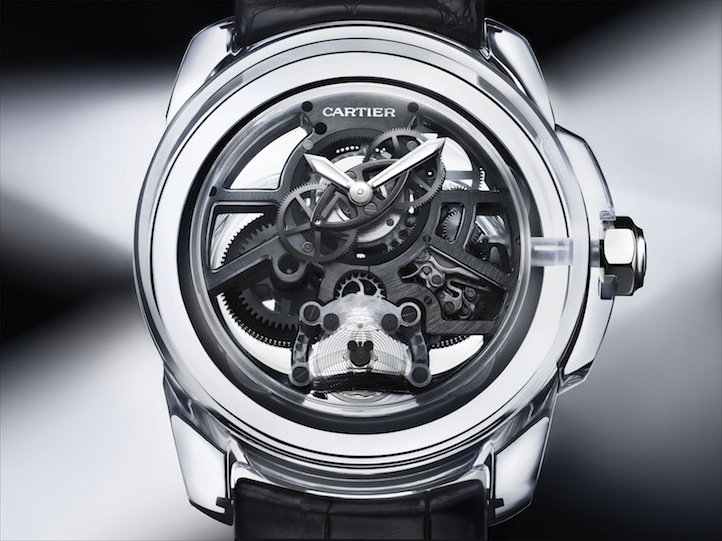Cartier’s ID Division Tells A New Tale In Time
08.01.2012
STYLE

Edouard Mignon is Cartier’s Product and Services Director where he’s in charge of the company’s Watchmaking Innovations. On the heels of the announcement of a new concept watch, ID Two – “ID” as in innovation and development and “ID “as in idea – this is the second concept watch following the introduction of ID One in 2009. The watch is revolutionary in a number of ways, most notably, through the use of materials and its vacuum case design, the watch reduces energy consumption by 50%, increases the stored energy by 30% and offers a 32 day power reserve. Like a concept car, the watch will not be available for sale, however, the innovation will applied to future Cartier watches. Here, Life+Times chats with Mr. Mignon about the science behind the method.
L+T: You’ve said “True innovation means clearing new paths never taken before and thinking up novel solutions.” How have you applied this statement to your role at Cartier?
Edouard Mignon: In our mind, innovation is the ability to transform creativity and dreams into reality. Therefore, you are looking for new territories and thinking out of the box. Innovation means rupture with your everyday life and your “comfort zone.” It is completely different from traditional product development where you are seeking little improvements on existing solutions. At Cartier, we have set a very clear objective for watchmaking innovation: Ultimately it has to serve the end customer by offering more performance or more reliability for the watches of the future. Indeed, from the very beginning of the history of watchmaking, there have been a lot of downturns in the way people manufacture watches, leading to some lacks of precision or resistance to the everyday life. And even though the most brilliant people of their days have worked on those subjects for several centuries, a lot of those problems still exist today. Our ultimate dream would be to have a watch that could last forever without servicing with a very high level of performance. But the challenge is hugely difficult: imagine that you usually have more than 200 components in a watch that has to work flawlessly 24 hours a day, 365 days a year!
L+T: Tell me a little bit about your job and what it entails. What are your responsibilities?
EM: I am in charge of product development and innovation for Cartier’s watchmaking department, which is located in La Chaux-de-Fonds, Switzerland, in the very heart of historical watchmaking. We have a team of more than 200 people who are dedicated to transform ideas of new products into the real life; it ranges from making technical drawings, prototypes, a laboratory for the homologation of the products up to the ability of making unique pieces for special orders. Since watches are a mixture of design, technique and emotion, you need to work in complete harmony in order to end up with good results. So we are working very closely with Cartier’s design and marketing departments in a way that we call the “studio.” We meet once a week in a dedicated place where we discuss the new products and make slight changes by trial and error up to the moment we are fully satisfied.

L+T: What is the mission of Cartier Watchmaking and timepieces? What is it about your watches that stand apart and make them unique?
EM: I would say that our motto is creativity. Obviously in the design, but also in the technique, which is truly unique. In traditional watchmaking, the watch case (the coachwork) and the movement (the engine) are two completely different worlds made by different people. At Cartier, we want those two worlds and the people working in those fields to share together so that we end up with a very homogeneous watch. A good example of that is the Santos skeleton which is a watch whose movement has been designed to be at the same time the engine and the dial of the watch. It seems that everything was conceived as a whole with the same level of attention to detail on each part of the watch giving a very harmonious result.
L+T: At Cartier, innovation can be seen in the watches themselves, but also in the methods and state of mind. What is the current perspective that you hold regarding Cartier watches?
EM: As you said, first of all innovation is a state of mind. If you visit our manufacturers, you’ll be surprised by the fact that we like to mix things. We mix people from very different backgrounds, for instance watchmakers with PhDs or engineers. But we also mix high technology with the highest level of craftsmanship. This is the kind of environment that leads to push the boundaries and think a bit differently. This is in this environment that we had the idea to tackle the traditional problems known in watchmaking in a very fresh and global approach. This is what led us to the “ID” concept watch program in order to show the people what could be the future of watchmaking. These concept watches are fantastic tools to make people work together on the same objective because they are working on a real watch that can be touched rather than a very obscure research and development project.
L+T: Innovation has always been a driving force of Cartier’s business values, and since 2007 has been accorded a dedicated structure dubbed the “Think Tank,” a four-story 3000 m2 building housing 135 watch engineers and specialists. Tell me a little bit about this? What’s it like inside? What were your first thoughts upon entering the Think Tank for the first time?
EM: The “Think Tank” is part of our innovative organization. Basically it is a building that is fully dedicated to the development of new products. It has been designed so that you follow physically the flow of an idea up to its realization when you walk into the building. You start with the technical offices, then you go to the prototyping workshop, then the lab where you test your solutions, then you end up by the tooling department where you manufacture the tools that will be needed to go into production: you can’t be a good craftsman if you don’t have the right tool! This is absolutely unique in the watchmaking world because in a traditional manufacture, all those people are separated in different departments or even in different locations. Here, everybody is under the same roof, always sharing together and improving the products . The level of attention to detail is therefore very high. The building itself has been designed to be fully transparent, with no closed office, in order to encourage teamwork. When you first enter the “Think Tank” you are amazed by the light and then you feel a very special atmosphere that is full of passion. You feel that everybody is working with a vision of the end product. You are not talking with watchmakers or engineers doing their specific jobs, you are talking with people who are part of an adventure. The sum is greater than its parts!
L+T: This is the place where the Cartier “Innovation & Development” concept, or “Cartier ID” for short, was born: a true laboratory of ideas where tomorrow’s watches are invented in partnership with cutting-edge industries and top universities. What was your role in this? Tell me a little bit more about Cartier ID and what it offers.
EM: The research and development team that works in the “Think Tank” works on many subjects at the same time because you have to have many ideas in order to get one that ultimately will make it into production. Innovation is a very tough process in which there is a lot of scrap! The objectives of this team are very simple: how to improve performance and reliability. Some of those ideas are transformed into a concept watch in order to materialize our vision of the future of watchmaking. The purpose of making a concept watch is to give the direction for the teams and stimulate their creativity. It is far easier to work on a real watch than to work on a “power point” project. However, those concept watches, which are not intended for sale, are nothing without the “D” of “ID”, which stands for development. Indeed, going into production is our ultimate goal since we’d like those major breakthroughs to be the future of our watches. It may take time since we are in rupture with what we know, but we are strongly committed to work on the industrialization of those ideas in a step by step approach. ID One was the first “adjustment-free” watch in 2009 with the vision of making a watch that could be near-eternal. A watch that doesn’t have to be serviced for the rest of its life and that could cope with the aggressions of the environment of the wearer such as shocks, vibrations, temperature changes, etc… Aggressions that a traditional watch struggles to cope with. The first commercial step in this direction will be released next year with a watch called the “Astrotourbillon Carbon Crystal” which incorporates some of the techniques and principles that were first studied in ID One. It will be the first step and obviously many more steps are to come.
L+T: What was the next step?
EM: Second chapter in our vision of the future of watchmaking is ID Two which explores the domain of efficiency in watchmaking since we have remarked that traditional watches are very inefficient mechanical devices. More than three quarter of the energy stored in a watch is simply wasted and not used to tell time! Thus working on efficiency can lead you to have access to levels of energy you couldn’t have dreamt of some years ago. It opens up new territories for the future of watchmaking: now we can dream of miniaturization without compromising with performance, we can dream of longer power reserve within the same size of watches or even of completely new functions since we have access to new levels of energy. And this is only the beginning! We’ll continue to dream about the future of watchmaking through the “ID” program but also we’ll continue to work hard in order to make those dreams come true in our current range of watches.





